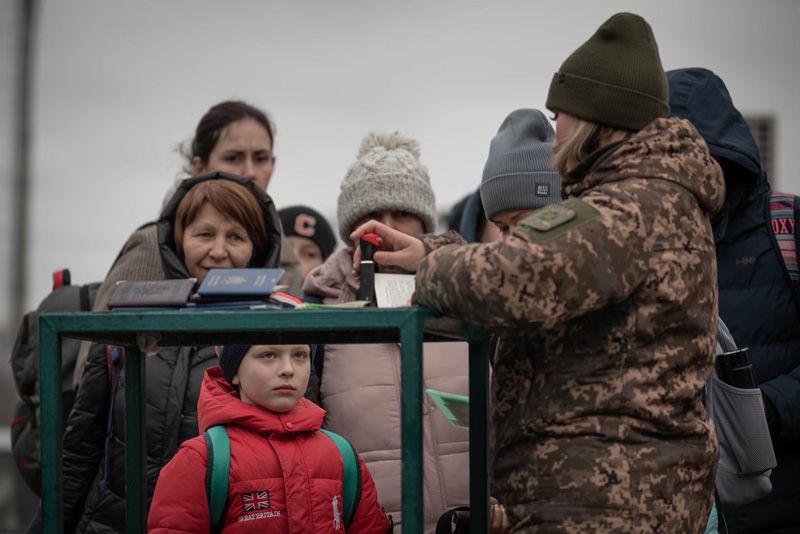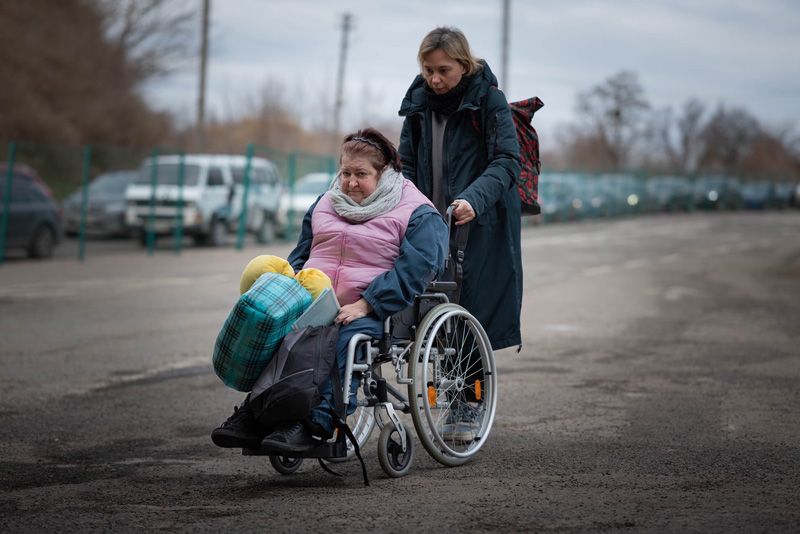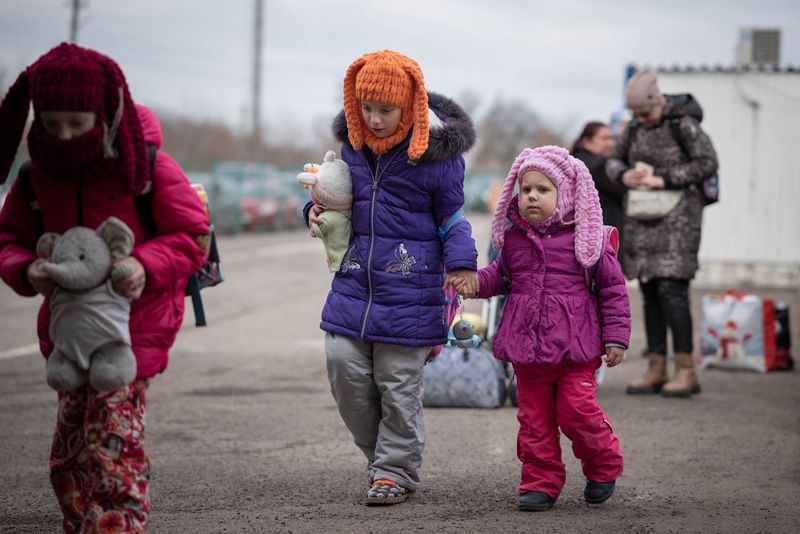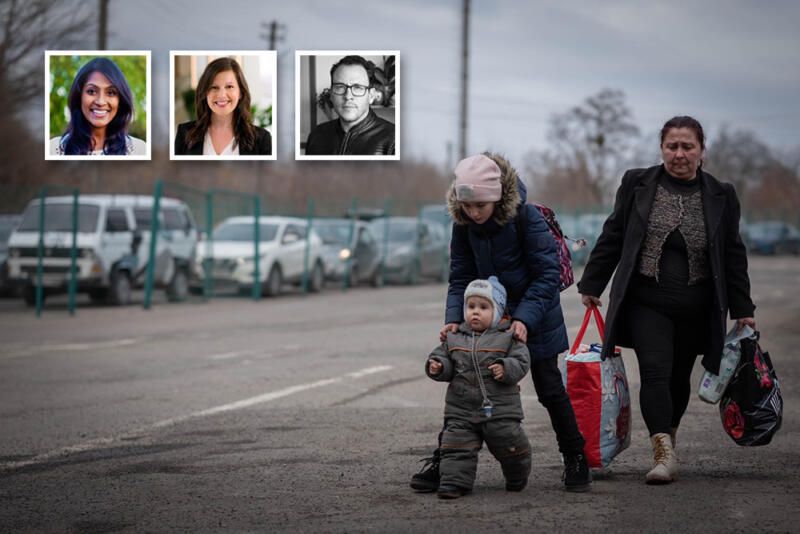One World for Ukraine: Helping Refugees from the Russia-Ukraine Conflict
(Above): (Inset, l-r): Krish O’Mara Vignarajah, President and CEO of Lutheran Immigration and Refugee Service – the U.S.’s largest faith-based nonprofit dedicated exclusively to serving refugees, asylum seekers, and other vulnerable immigrant groups; Natalia Banulescu-Bogdan, Associate Director of MPI’s International Program and a Nonresident Fellow with MPI Europe. She has primarily worked with MPI’s flagship initiative, the Transatlantic Council on Migration. Prior to joining MPI in 2008, she worked at the Brookings Institution; and Manuel Ortiz Escamez, a national award-winning (US) digital journalist, social researcher and professor. He is Co-founder of Peninsula 360 Press. (EMS) (Background): Refugees from Ukraine crossing into neighboring nations. (Ethnic Media Services Pool/Manuel Ortiz Escamez)

The fastest growing and largest refugee situation in Europe since World War II, more than two million Ukrainians have backed their country and refugees may top four million, maybe even more. This crisis adds to the record numbers of people, 84 million, who have been forcibly displaced worldwide. Experts – Krish O’Mara Vignarajah, President and CEO of Lutheran Immigration and Refugee Service – the U.S.’s largest faith-based nonprofit dedicated exclusively to serving refugees, asylum seekers, and other vulnerable immigrant groups;Natalia Banulescu-Bogdan, Associate Director of MPI’s International Program and a Nonresident Fellow with MPI Europe. She has primarily worked with MPI’s flagship initiative, the Transatlantic Council on Migration. Prior to joining MPI in 2008, she worked at the Brookings Institution; and Manuel Ortiz Escamez, a national award-winning (US) digital journalist, social researcher and professor. He is Co-founder of Peninsula 360 Press – examine the immediate impact of the crisis and who will be affected including other immigrants and refugees still waiting in long lines with very long backlogs.
EMS colleague journalist Manuel Ortiz, who is now inside Ukraine, and has been reporting at the Polish border, gave a first-hand account of what he’s seeing.
Natalia Banulescu-Bogdan from the Migration Policy Institute gave a global view of what’s going on in Ukraine and what is likely to be the impact of this refugee crisis, and how it fits with the rest of the world’s crisis.
Natalia began with an overview of what we’re seeing, how many have left, where people are going, and what their legal status is. She then briefly talked about the medium to long-term integration implications and needs, and then just a few notes on the longer-term implications for global protection writ large.
“There is a large Ukrainian diaspora in Poland and other EU countries host significant Ukrainian populations already as well. Many Ukrainians left for the EU when Russia seized Crimea in 2014 so it’s important to note that Ukrainians were already one of the largest sources of labor migrants in the EU prior to this conflict. If you look at 2020 data, 55 percent of the total residence permits awarded to non-EU nationals went to Ukrainians, mostly who went to Poland. Ukrainians were also one of the largest sources of international students in the EU. Putting in context where people might be choosing to go and where they already have family ties or previous work experiences, from what we’re seeing right now, the flows across the borders are mostly women and children. Male Ukrainian citizens aged 18 to 60 are not being let out of the country. This really distinguishes this cross-border flow from other displacement crises that we’ve seen in the past where a common pattern is to see single men traveling first,” said Natalia.
“We have estimated that there are more than 470,000 foreign nationals in Ukraine around 76,000 of them were international students, many from Africa, Asia and the Middle East. The situation at the border is mixed. On one hand we’re observing a much easier evacuation compared to other conflicts. It’s notable that all neighboring countries maintained open borders, and since 2017, Ukrainians have enjoyed visa-free travel for 90 days with the EU, which eases travel across the border particularly for those with documentation and biometric passports.

“On the other hand, we’re seeing some protection blind spots. There are a lot of concerns around protection for vulnerable groups crossing borders including unaccompanied children. EMS colleague journalist Manuel Ortiz Escamez reported from Ukraine, “There is not only people who are leaving Ukraine, there are also people entering Ukraine, even to fight or bring in medicine or other stuff. Once the people get there, they go underground. There is a bunker where people make a big line and they make lists so they decide which border are they going to. 60 percent of the of these people are going to Poland, but also a lot of people are going to Romania. The line where people have to stay, they already did maybe 30 hours, or many hours on the road and they have to stay here for hours. It’s very, very cold.
“After that the bus takes them close to the border but not right in the border so they have to walk again and it’s very difficult because most of the people are women with kids and elders and they are bringing very heavy stuff and they have to walk a lot.
“People are waiting at the border. After that they get stamped so they have to make another line which can take two or three hours because each person has to have the stamp and it’s a military checkpoint. There are elders and a lot of disabled people. A lot of elders are staying, some because they cannot do this long journey.
“Once they cross the border, there is huge solidarity and groups of people organized through social media. They’re volunteers, bringing hot food, which is very important because if they’re hungry and these weather conditions are extremely difficult so a Poland guy told me a musician that plays on the streets he gets some money playing on the street he came here donate food and he says that before this happened, before the attack he thought that Polish were very divided and at least for now they are joining to help and he made clear that is not the government because some media are reporting that the government is providing this all of these. Everybody on the shelter said the government have nothing to do with this. It is all just the people, no NGOs. There are some NGOs on the border checking because of what already was mentioned about Russia profiling,” reported Manuel Ortiz.

Krish O’Mara Vignarajah, president and ceo of Lutheran Immigration and Refugee Services spoke next about the situation from the U.S. point of view. What is that the U.S. has done, what should the U.S. do, and the political impact domestically.
“Europe and the neighboring nations are very much the front lines of this response. While the majority are in Poland, I think it’s also important to note that if you look at a per capita basis Moldova has also taken the highest number of refugees, particularly as Russian attacks continue and get closer to countries like Moldova, we are so starting to see some migration from Moldova as well. A host nation could become a nation that has refugees fleeing from there as well. That isn’t to say that the U.S. cannot play a significant role because I think that we can, of course our first response needs to be right now supporting our friends and allies in the region as they are responding to the immediate needs as the numbers continue to tick up.
“Vice President Harris is in the region, clearly countries like Poland are struggling under more than a million in the country and the U.S. initial investment of $54 million from the state department followed by another $53 million announced by Vice President Harris during her trip, the House and Senate just approved a $13.6 billion package for Ukraine and a little less than half of that will be for economic and humanitarian aid, that’s an important start because it will allow for the provision of food, shelter, drinking water, emergency health care, for example, but there are a few scenarios for how this refugee crisis could play out that could impact how the U.S. might respond.
“In a best-case scenario, the Russian invasion would ultimately fail, and many Ukrainians will be able to return to rebuild once it’s safe to do so. I only note that because we shouldn’t assume that everyone who has left the country would even want to come to the U.S. There are many cultural community and familial ties to neighboring countries and that is why we’re seeing those with family in Poland or even Germany, traveling to those countries, and Europe has been eager to welcome them. Granting them the temporary protection makes them eligible for social services for example, but that kind of program isn’t the case here in the U.S.
“We have a similar program in what we call temporary protected status but it is different in the sense that it essentially only allows an individual to enter the country and to offer a work authorization, basically an employment authorization document, it doesn’t offer the kind of robust support that is available through this newly created EU program and it’s retrospective and so it is time-limited, where if you were in U.S. by March 1st is when you would be considered eligible for that but in a worst-case scenario, where Russia is frustrated by its lack of progress and we see further attacks, obviously what you heard from Natalia and Manuel is what we are starting to see which is a significant uptick and we expect a larger and sustained exodus perhaps in excess of the UN’s projection of four million refugees.
“One EU commissioner put the total at a possible 7 million. In that case, we might see Europe’s capacity and willingness to accommodate refugees wear thin. There’s a real risk of backlash although we expect that is going to be far limited to what we’ve seen in the past and that’s where it’s going to be critical for the U.S. to step in a more robust and direct way. If and when that comes to pass, the U.S. needs to be ready with a refugee program that is nimble, that is prepared to accommodate much higher numbers and that capacity I would say exists but it is going to still require some work.
“The U.S. government needs to play a role in rehiring refugee officers, making sure they are what we call ‘writing circuit’ and conducting the interviews, that we are using more video conferencing capabilities, and through that rebuild. There is an opportunity for the U.S. to play a role here and Americans are overwhelmingly in support of welcoming refugees fleeing Ukraine,” said Vignarajah.


